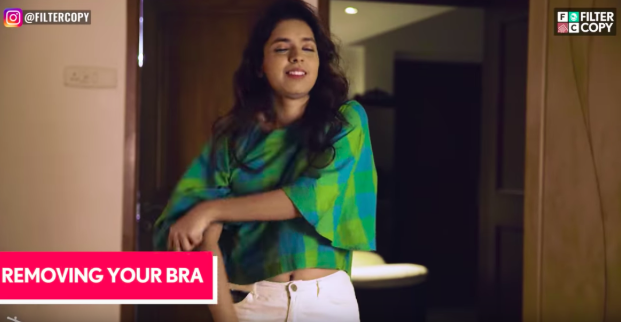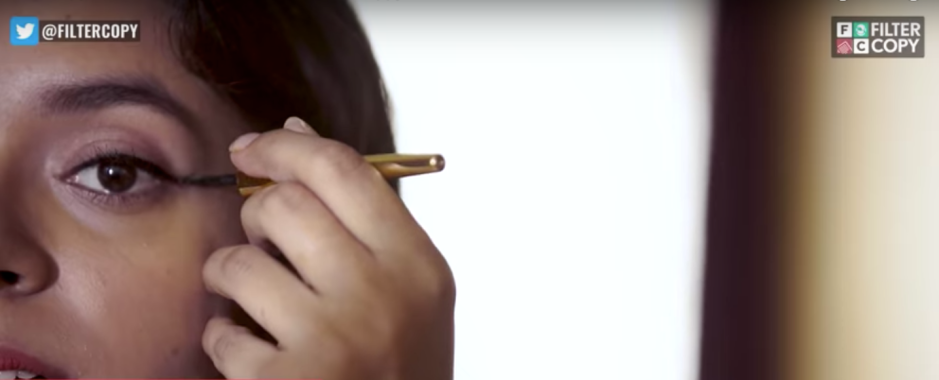There are many stressful, frustrating, and saddening things about being a woman. There is no dearth of things an average woman could be worrying about at any given point of time- whether she looks fine, whether she smells nice, whether her bra strap is showing, whether her skirt is flying up, whether her pants are too tight, whether her heels are about to break, whether her lipstick is on her teeth, whether her concealer is peeling off, whether her body hair is noticeable, whether her voice is too loud, whether the graze of a man’s hand was intentional, whether he’ll be offended if she says something, whether that stranger is staring at her, whether she can take out her phone without him noticing and send her location to someone, whether she should send the number of her cab to her parents, and so on and so forth. So when Filtercopy, a prominent Indian digital media site, posted this video called ‘Little Things that Make Women Happy’, I had many things in mind. My imagination was running free, the possibilities were endless! But as usual, patriarchal media got a simple premise so twisted, that I could not help but laugh.
The very first thing they could think of, which would spark joy in a woman’s mind, was not as one would expect, more freedom, less labour, more comfort, or less regulation. It was… wait for it… no lipstick stains.

The woman in the video is in the company of a group of people, and instead of talking or engaging with them, she’s deep in thought, carefully noticing how the other woman has left a lipstick mark on her cup, labouring under the worry that if she takes a sip of her drink, the same fate will befall her too.
How much does an average woman spend on lipsticks in her lifetime? Some estimates say as much as $I,780. That’s 1 lakh 26 thousand 1 hundred and 87 rupees. On the rest of her makeup, she spends a total of $15,000. Let us not even begin to calculate the time spent on applying each of these products.

Imagine the number of books one could read with that amount of money and time, or the amount of education one could access. Imagine what such resources could mean for a woman’s financial independence, what it could mean for a woman trapped in a bad marriage, faced by a harasser at her workplace, or burdened with legal fees in a fight against her abuser. Alternatively, imagine how indispensible a woman’s need to wear lipstick becomes for multi-billion dollar companies to exist, and what effect this economic system has on thousands of people, especially women, across the world. Imagine one such company opening a small media business for itself. What kind of video would it make, say, if it had to target half of its consumer base and at the same time get points for being relatable and representative? But I’m digressing. Let’s get back to the video.

Ah, my biggest worry in the world! Hairfall! I’m not surprised. With the amount of advertisements I’m bombarded with on an average day- for shampoo, conditioner, shampoo+conditioner, dry shampoo, hair oil, perfumed hair oil, non-sticky hair oil, hot hair oil, deep massage hair oil, hair serum, hair mask, hair spray, texture spray, hair colour, hair dye, hair mist, hair gel, hair bleach, heat protecting spray, hair straightener, hair curler, hair dryer, hair ties, hair clips, and hair brushes- it is of course a bit of a bummer when there’s nothing that can stop my hair from falling. I daresay it is a bummer for those selling the products too. But thinking about this makes up exactly two seconds of my day. You know what would make me much happier than a ‘no hair hairbrush’? If women around me were not constantly, instinctively, fixing their hair at all times. If like men, I didn’t need to spend a fortune to get a haircut. If my entire worth was not dependent on how feminine or pretty my hair looked. If I could spend the time I spend on combing my hair on doing something that added actual value to my life. If I didn’t have to buy a single hair product, and could get rid of the whole damn mane without fear of social consequence. But again, I’m digressing.

I know that feeling. That feeling when I was a young girl and my mother started insisting that I wear an extra layer under my t-shirt so that people wouldn’t look, and eventually took me to a shop where a man stared me down to determine the size of my breasts and suggested a bra size. That feeling when I saw discounts by so-called women’s brands for the most complicated of strappy, lacey, contraptions on valentine’s day, so that women could ‘surprise’ their partners. That feeling when I fell asleep without taking it off one night and woke up with the most painful ache in my chest. That feeling when I spent at least 10 minutes trying to discreetly adjust it in public so that no one would get any sight of it. Why on earth are we still talking in terms of ‘removing’ our bras at the end of the day instead of doing away with them altogether? Why are we so comfortable with our pain? Why are we so anxious to not be one of the uncool, bra-burning feminists? They sure seemed to have a point.

Have you ever been to a shopping mall and compared the women’s section to the men’s section? Mainstream feminist ideas today tell us to choose whatever we want to wear! In today’s day and age I can choose between shirt A and skirt B and dress C. But who said I have to choose between them? And who said that this choice adds anything at all to the quality of my life or my position in society? An easy look at the two sections of clothing will reveal a number of patterns- the average length of women’s shorts is disproportionately less than that of men’s, the average fit of pants disproportionately tighter. Whether it be short skirts or off shoulder dresses, crop tops or heels, ruffles or chokers- women’s fashion seems to be designed to restrict movement and make us appear smaller. What good does it do to speak up against sexualisation of women based on what we wear when the odds are that what we wear is in itself controlled by an industry run by men, which depends on the sexualisation of our bodies? Why is it absolutely ordinary to joke about not eating or to worry about how much I will have to hold my breath to fit into a pair of pants? Why should a significant moment of happiness in my everyday life involve fitting into jeans whose only purpose is to make my legs look thinner and my butt stick out? I’m sure even those feminists who argue for choice would not disagree with the fact that there is nothing inherent about being a woman that necessitates this difference in design in our clothing.

In Mumbai, one of the major metropolitan cities in India, there are around 10,778 public toilets for men, and only 3909 for women. Even out of the ones that are present, many shut down at night, while men’s toilets remain open. What is made to look like individual women’s paranoia about cleanliness and men’s tendency to be careless with their bathrooms perhaps points to a much larger structural problem- that a much higher number of women with much more need for clean water and sanitation have to navigate public spaces with less than one-third of the resources available to men. What implication does that have on women’s mobility and access to public space? Perhaps, rather than a coincidental encounter with a clean toilet, infrastructural changes which lead to clean toilets becoming commonplace for women would be a ‘little thing’ that I’d much rather be happy about.

A Hindu tradition called ‘Chaupadi’ followed in Nepal makes menstruating women and girls live in isolated huts for the duration of their period. In these huts, women die from snake bites and suffocation, and are vulnerable to rape. Numerous girls in Kenya engage in transactional sex in order to access period products because of the prevalent culture of shame and stigma. Films such as Pad Man make heroes out of men for teaching women how to manage their own periods. The most common products women use (sanitary napkins and tampons) create an immense amount of waste, can have fatal health impacts, and are too expensive for most women to be able to afford. However, the pressure to conceal our periods and all signs of it, ensures that we are unquestioning consumers of anything that makes our period as invisible and separate from our bodies as possible. This is why women are constantly targeted with ads for the new perfumed pad, the new triple layer extra thick pad, the extra long pad, and so on and so forth. Forget free-bleeding, even “practical” options such as cloth pads and menstrual cups, which are not only biodegradable but also reduce pain, infection, and discomfort, do not find nearly as many users. This is because wearing them means that we can’t immediately wrap our blood in plastic and discard of it, we can’t avoid touching our blood, we can’t avoid people finding out about our blood. When saviours (especially white, especially male) come bearing gifts of sanitary pads for naive, unknowing, poor, rural women thinking they will bring gender equality to them, what they do not consider is that the availability of pads has not particularly reduced the stigma of menstrual blood for anyone. It has only made it easier to hide. How dare someone suggest, then, that our happiness be born out of this shame?

The last thing they say women feel happy about, is ‘feeling safe’. Here, they are not wrong. For, what other choice do we have than to be satisfied with little concessions in the constant threat of violence? Especially when media companies like this one do everything in their power to normalise our position as recipients of it? One thing is clear, that Filtercopy is not a villain. Sure, it wants us to stay in our place, but at least it wants us to be happy while we do it.


